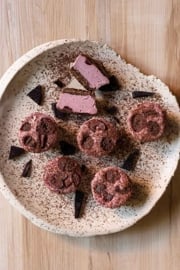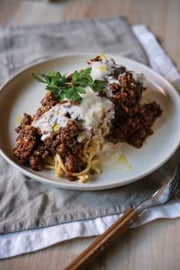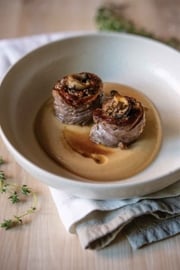
Many of us have heard stories of bygone days when lobster was considered poor man’s food. Now the price of lobster makes it a special occasion treat, no longer something fishermen use as bait or garden fertilizer, which is all the more reason to avoid waste and use it entirely — antenna to tail. Ask your fishmonger to choose females for this recipe, only the female lobsters will have the roe (eggs) needed to flavor the butter for the sauce. (Raw lobster eggs are dark green and called roe, when the eggs are cooked they turn red and are called coral.) Making fresh pasta is easier than you think. If you’re not ready to take the leap, substituting your favorite dried pasta will still yield delicious results.
This recipe requires you to work with live lobsters in order to get the roe and extract the maximum flavor from the shellfish. If this is something you object to, I encourage you to skip this recipe.
Saffron Pasta with Lobster
Ingredients
- 3 live 1 1/4 lbs female lobsters
- lobster roe
- 2 lbs unsalted butter
- 3 lobster bodies
- 1/2 tsp saffron
- 60 ml cold water
- 1 egg
- 2 c all-purpose flour
- 1/2 c onions
- 2 tbsp olive oil
- 2 c royal trumpet mushrooms
- 1 1/2 c lobster stock, or water
- 1/2 lemon
- 1/8 c fresh parsley
- Sea salt and black pepper, to taste
Directions
01
Lobster
Bring a large pot of salted water (4 tablespoons salt per gallon of water) to boil; leave room for the lobsters. Place the tip of your chef’s knife behind the lobster’s eyes, right below where the claws meet the body; firmly push the knife down through the head. This will instantly and humanely kill the lobster, though due to nerves the legs may continue to move a bit. Twist the tail and claws from the body to remove them. Remove the dark green roe from the tail; set aside. Add lobster claws and tails to the pot and boil for 7 minutes. While lobster is cooking, prepare an ice water bath in a sink or large pot. Remove lobster and immediately put in ice water. Once cool, clean the meat from the shells. Cut into bite-sized pieces; set aside.
02
Lobster coral butter
Clean the lobster bodies: Remove the stomach (located directly behind the head) and light green tomalley and discard. Save any dark green roe left at the bottom of the body; set aside. Melt 1 pound of butter in a medium pan; add the lobster bodies and slowly cook on medium to low heat (you want to keep the milk solids and creaminess so do not brown or clarify). Simmer for 10 minutes, stirring often. Remove from heat. Strain through a fine mesh seive, pressing the shells roughly to extract all the butter and lobster flavor. Cool until mostly solid, room temperature. Combine infused butter with remaining 1 pound room-temperature butter and uncooked coral in the bowl of a mixer. Use the whisk attachment to whip the butter together until light green and fluffy. You’ll have more lobster coral butter than you need for this recipe. Freeze any extra butter for the next time you make this pasta.
03
Saffron pasta
Add saffron to water and let sit for 15 minutes. Combine egg with saffron water. Place flour in food processor and while running, slowly pour in egg-water mixture until it is combined. Remove and knead by hand until smooth. Rest dough in the refrigerator for at least an hour. Once dough is rested, work the dough through the roller or extruder into your favorite pasta shape. Spaghetti, rigatoni, and garganelli are my favorite shapes for this recipe.
04
To finish
Boil salted water (roughly same salt to water ratio as for the lobster) for pasta. Dice the onions small; start cooking them in a large skillet with the olive oil. Once halfway cooked, add thinly-sliced mushrooms; cook until lightly golden brown. Add lobster stock to skillet and boil to reduce slightly. While stock is boiling, add 4 tablespoons lobster coral butter, juice of one half lemon, and chopped parsley. (Notice the color of the sauce change from light green to light orange or pink as coral cooks.) When pasta water boils, add pasta. Just before desired doneness, strain, and add to the skillet. Cook pasta in skillet for a minute to absorb the sauce. At the very end, add diced lobster meat; do not overcook. Season with salt and pepper.





